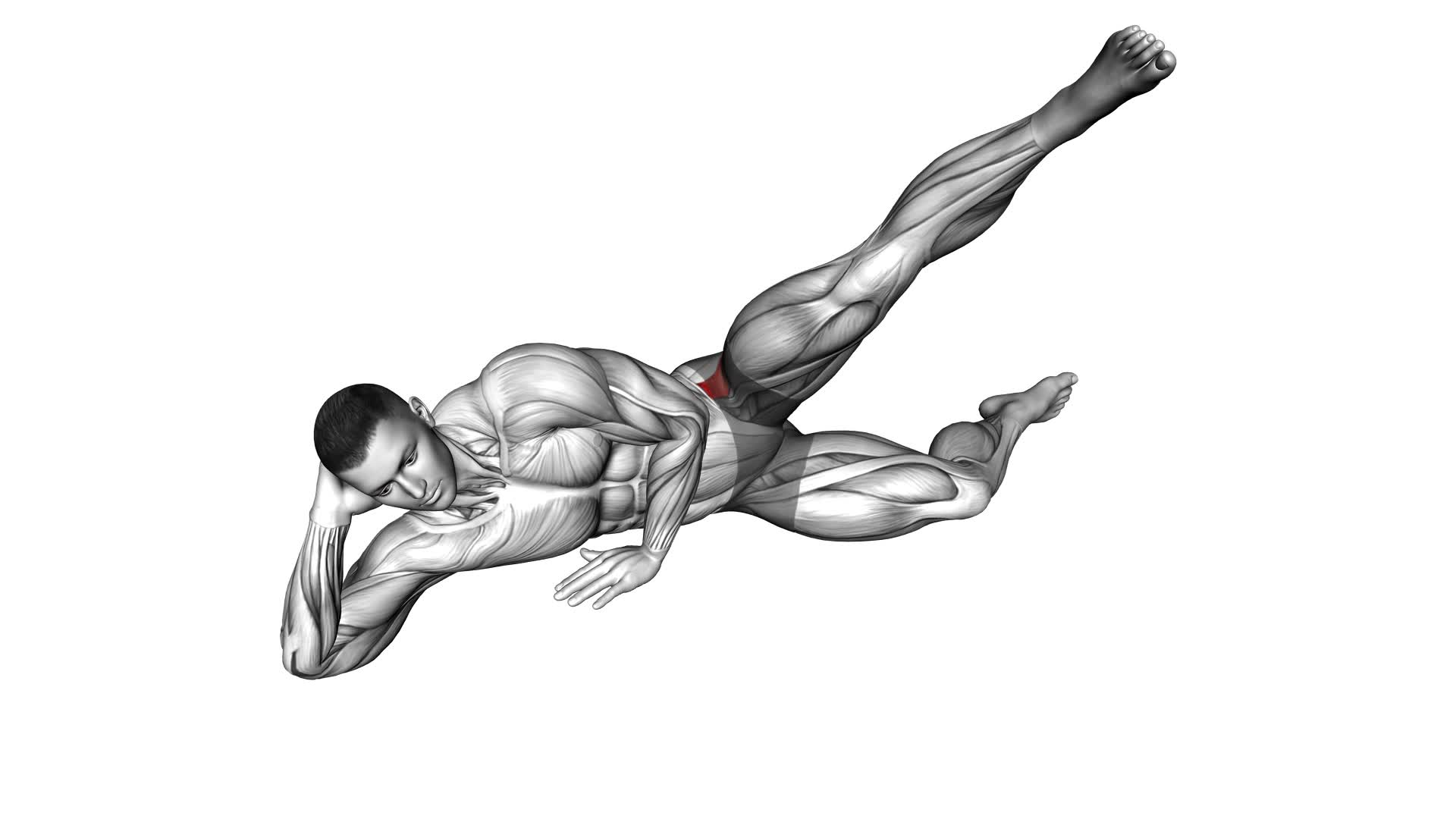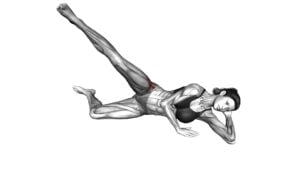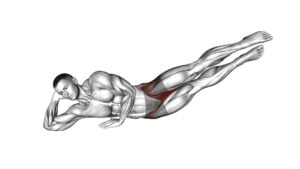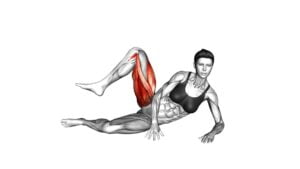Side Lying T Thigh Raise (male) – Video Exercise Guide & Tips

Looking to sculpt your thighs? Check out this video exercise guide on the Side Lying T Thigh Raise.
Watch This Exercise Video
In this tutorial, you'll learn the proper form and technique for this effective exercise. Avoid common mistakes and discover variations to challenge yourself. Get the most out of this workout with expert tips.
Get ready to tone and strengthen your thighs with this targeted exercise.
Let's get started!
Key Takeaways
- Side Lying T Thigh Raise improves core strength and hip stability.
- The exercise targets muscles in the hips, glutes, and core.
- Proper form and technique are important, focusing on engaging the core and keeping the leg straight and in line with the body.
- Modifications can be made for different fitness levels, and gradually working up to the full range of motion is recommended.
Benefits of Side Lying T Thigh Raise
Improve your core strength and hip stability with the Side Lying T Thigh Raise. This exercise targets the muscles in your hips, glutes, and core, helping to improve overall stability and balance. By performing this exercise regularly, you can strengthen these muscles, reducing the risk of injury and improving your athletic performance.
To perform the Side Lying T Thigh Raise, start by lying on your side with your legs straight and stacked on top of each other. Place your bottom arm underneath your head for support, and place your top hand on the floor in front of you for balance. Engage your core and lift your top leg as high as you can, keeping it straight and in line with your body. Hold for a moment at the top, then lower your leg back down.
This exercise can be modified to increase or decrease the difficulty level. To make it more challenging, add a resistance band around your ankles or hold a dumbbell on your top thigh. To make it easier, bend your bottom leg and rest your foot on the ground for support.
Incorporating the Side Lying T Thigh Raise into your workout routine can help you develop strong and stable hip muscles, improving your overall athletic performance and reducing the risk of injury.
Proper Form and Technique
To perform the Side Lying T Thigh Raise correctly, you should frequently engage your core and lift your top leg as high as possible while keeping it straight and in line with your body. This exercise primarily targets the hip abductors, which are the muscles responsible for moving your leg away from the midline of your body.
However, there are some common misconceptions about the proper form and technique for this exercise that need to be addressed.
One common misconception is that you need to lift your leg as high as possible to get the most benefit from the exercise. While it's important to lift your leg as high as you can without compromising form, it's more important to focus on the quality of the movement rather than the height. Make sure to keep your leg straight and in line with your body throughout the movement to effectively engage the hip abductors.
Modifications and regressions can be made to accommodate different fitness levels and abilities. If you find it challenging to keep your leg straight, you can slightly bend the knee or use a resistance band around your thighs to provide some assistance. Additionally, if lifting your leg is too difficult, you can start by performing the exercise with your knee bent and gradually work your way up to the full range of motion.
Remember to listen to your body and adjust the exercise as needed to maintain proper form. By engaging your core and lifting your leg correctly, you can maximize the benefits of the Side Lying T Thigh Raise and avoid unnecessary strain or injury.
Common Mistakes to Avoid
One common mistake to avoid when performing the Side Lying T Thigh Raise is allowing your leg to drop below hip level. Maintaining proper form is crucial for maximizing the effectiveness of this exercise and preventing injury.
When you allow your leg to drop below hip level, you reduce the tension on your thigh muscles, making the exercise less challenging and less effective. To ensure proper form, start by lying on your side with your legs extended and stacked on top of each other. Keep your torso stable and engage your core muscles. As you lift your top leg, make sure to keep it parallel to the ground, reaching a height that's in line with your hip. Avoid swinging your leg or using momentum to lift it higher.
By maintaining control and keeping your leg at hip level, you'll effectively target your thigh muscles and achieve better results.
Now that you're aware of the common mistake to avoid, let's move on to variations to challenge yourself and take your Side Lying T Thigh Raise to the next level.
Variations to Challenge Yourself
To challenge yourself further, try incorporating resistance bands into your Side Lying T Thigh Raise. This advanced modification won't only increase the difficulty of the exercise but also enhance muscle activation in your thighs and glutes.
To perform the Side Lying T Thigh Raise with resistance bands, start by lying on your side with your legs extended and stacked on top of each other. Place the resistance band around your ankles and hold onto the other end with your top hand. As you lift your top leg up into the T position, the resistance band will provide added resistance, forcing your muscles to work harder.
The incorporation of resistance bands in this exercise can help to strengthen the muscles of your hips and thighs, including the gluteus medius and minimus, as well as the quadriceps. The added resistance challenges your muscles in new ways, leading to greater muscle activation and overall strength gains.
It is important to choose a resistance band with an appropriate level of tension for your fitness level. Start with a lighter band and gradually increase the tension as your strength improves. Remember to maintain proper form and control throughout the exercise to maximize its benefits and prevent injury.
Tips for Getting the Most Out of This Exercise
Get the most out of this exercise by focusing on proper form and engaging your core throughout the movement. To maximize the benefits of the Side Lying T Thigh Raise, it's important to pay attention to your technique and make sure you're performing the exercise correctly.
First and foremost, concentrate on maintaining proper alignment. Lie on your side with your legs stacked and your body in a straight line. Keep your neck in a neutral position and avoid any excessive twisting or bending.
As you lift your top leg, engage your core muscles to stabilize your body. This won't only help to improve your balance but also increase the effectiveness of the exercise. Remember to breathe throughout the movement, inhaling as you lower your leg and exhaling as you raise it.
To get stronger and improve flexibility, gradually increase the number of repetitions and sets as your fitness level improves. Additionally, you can incorporate resistance bands or ankle weights to add an extra challenge to the exercise.
It's important to listen to your body and avoid pushing yourself too hard. If you experience any pain or discomfort, stop the exercise and consult with a healthcare professional.
Frequently Asked Questions
How Many Sets and Repetitions Should I Do for Side Lying T Thigh Raise?
For the side lying T thigh raise, you should aim for 3 sets of 12-15 repetitions. This exercise targets your outer thighs and strengthens your hip muscles.
If you're a beginner, you can modify by reducing the number of repetitions or using lighter weights. Remember to maintain proper form throughout the exercise, engaging your core and keeping your body aligned.
Gradually increase the intensity as you get stronger and more comfortable with the movement.
Can I Do This Exercise if I Have Knee or Hip Pain?
If you have knee or hip pain, it's important to consult with a healthcare professional before attempting the Side Lying T Thigh Raise exercise. They can assess your condition and provide modifications or alternative exercises that are safe for you to do.
It's crucial to prioritize your health and avoid aggravating any existing injuries. Beginners can also benefit from starting with modified versions of this exercise to gradually build strength and prevent injury.
Is It Better to Use Ankle Weights or Resistance Bands for This Exercise?
When doing the Side Lying T Thigh Raise, you might be wondering whether to use ankle weights or resistance bands. Both options have their benefits.
Ankle weights can add extra resistance to challenge your muscles, while resistance bands provide continuous tension throughout the exercise.
Ultimately, the choice depends on your personal preference and fitness goals.
Regardless of which you choose, the Side Lying T Thigh Raise is a great exercise for targeting your outer thighs and strengthening your hip muscles.
Can I Incorporate Side Lying T Thigh Raise Into My Daily Routine for Weight Loss?
Yes, you can definitely incorporate the side lying T thigh raise into your daily routine for weight loss. This exercise targets your outer thigh muscles and can help tone and strengthen them.
However, it's important to remember that weight loss is a holistic process and can't be achieved by just one exercise alone.
To maximize your results, consider incorporating other alternative exercises for weight loss and incorporating the side lying T thigh raise into a full body workout routine.
Are There Any Modifications for Beginners Who May Find This Exercise Too Challenging?
If you're a beginner and find the side lying T thigh raise exercise too challenging, don't worry! There are modifications you can try to make it more manageable.
You can start by bending your knees slightly or reducing the range of motion.
Another alternative is to perform a side-lying leg lift instead, which targets similar muscles.
Remember to listen to your body and gradually increase the difficulty as you get stronger.
Conclusion
In conclusion, the side lying T thigh raise is an effective exercise for targeting and strengthening the muscles in the outer thigh and hip area.
By maintaining proper form and technique, you can maximize the benefits of this exercise and avoid common mistakes.
For those looking to challenge themselves, variations can be incorporated to increase difficulty.
Remember to follow the tips provided to get the most out of your workout and achieve optimal results.

Author
Years ago, the spark of my life’s passion ignited in my mind the moment I stepped into the local gym for the first time. The inaugural bead of perspiration, the initial endeavor, the very first surge of endorphins, and a sense of pride that washed over me post-workout marked the beginning of my deep-seated interest in strength sports, fitness, and sports nutrition. This very curiosity blossomed rapidly into a profound fascination, propelling me to earn a Master’s degree in Physical Education from the Academy of Physical Education in Krakow, followed by a Sports Manager diploma from the Jagiellonian University. My journey of growth led me to gain more specialized qualifications, such as being a certified personal trainer with a focus on sports dietetics, a lifeguard, and an instructor for wellness and corrective gymnastics. Theoretical knowledge paired seamlessly with practical experience, reinforcing my belief that the transformation of individuals under my guidance was also a reflection of my personal growth. This belief holds true even today. Each day, I strive to push the boundaries and explore new realms. These realms gently elevate me to greater heights. The unique combination of passion for my field and the continuous quest for growth fuels my drive to break new ground.







